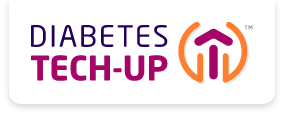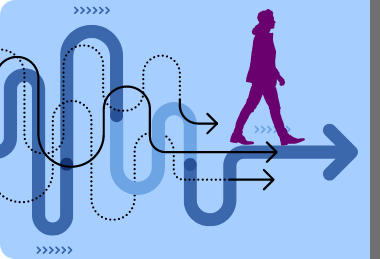How many of these 5 diabetes devices and tech tools have you integrated into your treatment process?
By Amy Tenderich, MA
6 min read

When the Medtronic MiniMedTM 502 came out in 1983, many people thought the golden age of diabetes tech was upon us.
It’s an understatement to say that we’ve come a long way in the last 40 years. I believe we are now in the golden age of diabetes tech (although I’m sure in another 40 years they will be saying the same thing).
Still, despite all the innovative diabetes digital health tech that’s out there, I experience the antiquated notion that “tech is for the type 1s” on a regular basis. Today’s tech tools should be considered for appropriate people looking to manage their diabetes, regardless of type.
Here are the 5 pieces of tech I think every primary care practice should be considering for their appropriate patients with diabetes. For this article, I’ll focus primarily on tech for people taking insulin.
1. Diabetes management apps1,2,3

It’s rare these days for me to come across a fellow person with diabetes who doesn’t have a smartphone. I see diabetes management apps as a great “gateway tech.” For anyone already using a smartphone, installing a new app is something they’re generally familiar with. In my experience, once they see how the app works and how technology can help them in their diabetes care, it may help them open up to other types of tech.
Some of today’s apps sync with CGMs, connected insulin pens/pen caps, and insulin pumps (all of which I’ll discuss shortly), and they allow people to track other lifestyle factors that impact their diabetes, such as eating patterns and physical activity.
When a patient shares diabetes data from the app with their care team, it can help give providers a clearer picture of that person’s condition to help inform treatment decisions and better conversations.
2. Continuous glucose monitors (CGMs)4,5
CGMs continuously monitor interstitial glucose levels throughout the day and night through a sensor inserted subcutaneously into the skin.
Wearing a bulky CGM can be a barrier for people who don’t want to draw attention to their condition, but today’s CGMs are much smaller and more discreet than their predecessors.
Today’s CGMs also offer a variety of special features, depending on the model. For example, if a child’s glucose drops dangerously low overnight, some CGMs can send an alert to wake a parent in another room.
When paired with a smart insulin pen or pump, providers can also get a better picture through the person’s ambulatory glucose profile (AGP) report, which includes “time in range” and how ups and downs in glucose are affected by insulin doses, meals, time of day, etc. I’ve found that many people with diabetes are striving for improved glucose control but struggle with the hassle of logging their glucose levels manually. CGMs automatically provide useful logs, which can be shared with health care providers to help uncover areas where patients could potentially make changes.
3. Smart insulin pumps2,4

Today’s insulin pumps not only do what they’ve always done (deliver small doses of insulin continuously at a basal rate or as bolus doses before meals to help control glucose levels), but they also record all this data so it can help inform patients and providers alike.
Like smart insulin pens and pen caps, smart insulin pumps can sync with diabetes management apps and CGMs to help form a clearer picture of what’s affecting glucose levels throughout a typical day.
Today’s insulin pumps are small, discreet, and some also offer tubeless technology, which has helped many people I know get over the hump and give a pump a try.
4. Smart insulin pens and connected pen caps1,5
For people with diabetes who don’t want to wear a pump but could benefit from automated insulin dose logging, smart/connected insulin pens and pen caps may also be an option. These devices have a sensor to record the date, time, and dosage of insulin injections so people don’t have to track their doses manually in a logbook.
All that data then gets wirelessly and securely transferred to a compatible diabetes management app and can be shared with health care providers.
When insulin dose and administration data is paired with glucose data collected via CGM, providers can assess the information and determine if any adjustments need to be made to the individual’s insulin routine.

CGMs automatically provide useful logs, which can be shared with health care providers to help uncover areas where patients could potentially make changes.
5. Automated Insulin Delivery (AID) systems3,6
Formerly called “artificial pancreas” technology, new AID systems may be beneficial for people with diabetes who are insulin dependent. Many companies and individual innovators are developing versions of AID; the systems are still evolving and not available to everyone yet, but the technology is on the horizon to make them more widely accessible.
An AID system is a combination of a CGM, a control algorithm that analyzes the data and calculates the required insulin dose, and a smart insulin pump that communicate with each other wirelessly, creating a “closed loop” that mimics what a healthy pancreas does. The system monitors glucose levels and delivers appropriate insulin doses throughout the day and night.
The CGM checks the patient’s glucose level, the algorithm determines if and when an insulin dose is needed, and the pump delivers the right dose at the right time—in an ideal version of the closed-loop system, it’s completely autonomous. And of course, as is the theme with today’s diabetes tech, the device captures the glucose level and insulin dosing data to help inform the patient and health care provider.
While the potential benefits are obvious, for now, AID systems require people with diabetes to wear two separate pieces of tech (the CGM and the pump). This may be a dealbreaker for some, but I’m excited to see how this tech evolves in the future.
Tech-up Follow-ups
- Identify one common diabetes management challenge your patients face.
- Identify the digital health tools you could implement to help tackle that challenge.
- Schedule time with your staff or team to discuss what it would take to implement each tool and prioritize the list of tools to implement.

Amy Tenderich, MA
Santa Barbara, California
Amy is a journalist, nationally known patient advocate, and diabetes tech expert. She was the founder and editor of DiabetesMine.com and former Editorial Director of Diabetes & Patient Advocacy at Healthline Media. She organizes and hosts the biannual DiabetesMine Innovation Forums (Innovation Summit, D-Data ExChange) that connect patient and industry leaders. Amy also lives with diabetes, having been diagnosed with type 1 diabetes in 2003.
Amy Tenderich received a fee from Novo Nordisk for her participation.
References
- Kerr D, Edelman S, Vespasiani G, Khunti K. New Digital Health Technologies for Insulin Initiation and Optimization for People With Type 2 Diabetes. Endocr Pract. 2022;28(8):811-821. doi:10.1016/j.eprac.2022.04.006
- Kesavadev J, Saboo B, Krishna MB, Krishnan G. Evolution of Insulin Delivery Devices: From Syringes, Pens, and Pumps to DIY Artificial Pancreas. Diabetes Ther. 2020;11(6):1251–1269. doi:10.1007/s13300-020-00831-z
- Arbiter B, Look H, McComb L, Snider C. Why Download Data: The Benefits and Challenges of More Diabetes Data. Diabetes Spectr. 2019;32(3):221-225. doi:10.2337/ds18-0099
- Didyuk O, Econom N, Guardia A, Livingston K, Klueh U. Continuous Glucose Monitoring Devices: Past, Present, and Future Focus on the History and Evolution of Technological Innovation. J Diabetes Sci Technol. 2021;15(3):676-683. doi:10.1177/1932296819899394
- Sy SL, Munshi MM, Toschi E. Can smart pens help improve diabetes management? Diabetes Metab J. 2021;45(6):813-839. doi:10.4093/dmj.2021.0177
- Moon SJ, Jung I, Park C. Current Advances of Artificial Pancreas Systems: A Comprehensive Review of the Clinical Evidence. Diabetes Metab J. 2021;45(6):813-839. doi:10.4093/dmj.2021.0177
The Diabetes Tech-upTM Podcast
Join our expert cohosts for a series of discussions about how they’re integrating diabetes tech with patient-centered care to help optimize diabetes management.
The Mission of Diabetes Tech-upTM
Diabetes Tech-upTM is sponsored by Novo Nordisk, a global leader in diabetes. We believe that adoption of innovative technologies can help appropriate patients better manage diabetes. Our goal is to provide information to help health care professionals on the front line of diabetes care strengthen their understanding of diabetes technologies and implement them where they can have the greatest impact.




Share: